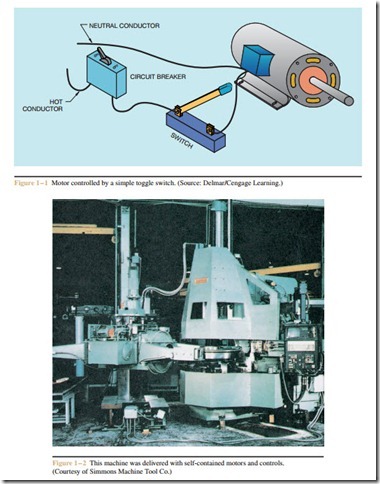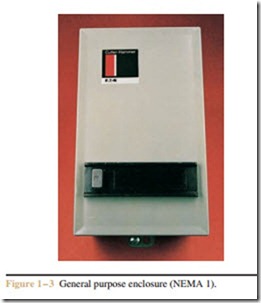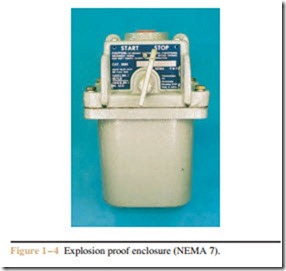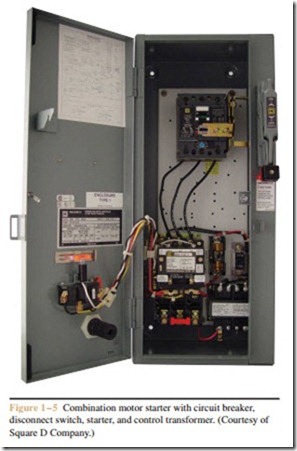The term “motor control” can have very broad meanings. It can mean anything from a simple toggle switch in- tended to turn a motor on or off (Figure 1–1) to an extremely complex system intended to control several motors, with literally hundreds of sensing devices that govern the operation of the circuit. The electrician working in industry should be able to install different types of motors and the controls necessary to control and protect them and also to troubleshoot systems when they fail.
Installation of Motors and Control Equipment
When installing electric motors and equipment, several factors should be considered. When a machine is in- stalled, the motor, machine, and controls are all interrelated and must be considered as a unit. Some machines will have the motor or motors and control equipment mounted on the machine itself when it is delivered from the manufacturer, and the electrician’s job in this case is generally to make a simple power connection to the machine. A machine of this type is shown in Figure 1–2. Other types of machines require separately mounted mo- tors that are connected by belts, gears, or chains. Some machines also require the connection of pilot sensing devices such as photo switches, limit switches, pressure switches, and so on. Regardless of how easy or complex the connection is, several factors must be considered.
Power Source
One of the main considerations when installing a machine is the power source. Does the machine re- quire single-phase or three-phase power to operate?
What is the horsepower of the motor or motors to be connected? What is the amount of in-rush current that can be expected when the motor starts? Will the motor require some type of reduced voltage starter to limit in-rush current? Is the existing power supply capable of handling the power requirement of the ma- chine or will it be necessary to install a new power system?
The availability of power can vary greatly from one area of the country to another. Power companies that supply power to heavily industrialized areas can generally permit larger motors to be started across-the- line than companies that supply power to areas that have light industrial needs. In some areas, the power company may permit a motor of several thousand horse- power to be started across-the-line, but in other areas the power company may require a reduced voltage starter for motors rated no more than one hundred horsepower.
Motor Connections
When connecting motors, several factors should be considered, such as: horsepower, service factor (SF), marked temperature rise, voltage, full load current rating, and National Electrical Manufacturers Association (NEMA) Code letter. This information is found on the motor nameplate. The conductor size, fuse or circuit breaker size, and overload size are generally deter- mined using the National Electrical Code (NEC®) and/or local codes. It should be noted that local codes generally supersede the National Electrical Code and should be followed when they apply. Motor installation based on the NEC® will be covered in this text.
Motor Type
The type of motor best suited to operate a particular piece of equipment can be different for different types of machines. Machines that employ gears generally require a motor that can start at reduced speed and increase speed gradually. Wound rotor induction motors or squirrel cage motors controlled by variable frequency drives are generally excellent choices for this requirement. Machines that require a long starting period, such as machines that operate large inertia loads such as flywheels or centrifuges, require a motor with high starting torque and relatively low starting current. Squirrel cage motors with a type A rotor or synchronous motors are a good choice for these types of loads. Synchronous motors have an advantage in that they can provide power factor correction for themselves or other inductive loads connected to the same power line.
Squirrel cage motors controlled by variable frequency drives or direct current motors can be employed to power machines that require variable speed. Squirrel cage induction motors are used to power most of the machines throughout industry. These motors are rugged
Controller Type
The type of controller can vary depending on the requirements of the motor. Motor starters can be divided into two major classifications: NEMA (National Electrical Manufacturers Association) and IEC (International Electrotechnical Commission). NEMA is an American organization that rates electrical components. NEMA starter sizes range from 00 through 8. A NEMA size 00 starter is rated to control a 2 horsepower motor connected to a 460 volt three- phase power supply. A size 8 starter will control a 900 horsepower motor connected to a 460 volt three- phase power source. IEC starter sizes range from size A through size Z. Size A starters are rated to control a 3 horsepower motor connected to a 460 volt three- phase source. Size Z starters are rated to control a 900 horsepower motor connected to a 460 volt source. It should be noted that the contact size for an IEC starter is smaller than for a NEMA starter of the same rating. It is common practice when using IEC starters to increase the listed size by one or two sizes to compensate for the difference in contact size.
Environment
Another consideration is the type of environment in which the motor and control system operates. Can the controls be housed in a general purpose enclosure similar to the one shown in Figure 1–3, or is the system subject to moisture or dust? Are the motor and controls
and have a proven record of service unsurpassed by any other type of power source. Figure 1 – 3 General purpose enclosure (NEMA 1).
to be operated in a hazardous area that requires explosion proof enclosures similar to that shown in Figure 1–4? Some locations may contain corrosive vapor or liquid, or extremes of temperature. All of these conditions should be considered when selecting motors and control components. Another type of starter commonly found in industry is the combination starter (Figure 1–5). The combination starter contains the dis- connecting means, fuses or circuit breaker, starter, and control transformer. They may also have a set of push buttons or switches mounted on the front panel to control the motor.
Codes and Standards
Another important consideration is the safety of the operator or persons that work around the machine. In 1970, the Occupational Safety and Health Act (OSHA) was established. In general, OSHA requires employers to provide an environment free of recognized hazards that are likely to cause serious injury.
Another organization that exhibits much influence on the electrical field is Underwriters Laboratories (UL). Underwriters Laboratories was established by insurance companies in an effort to reduce the number of fires caused by electrical equipment. They test equipment to determine if it is safe under different conditions. Approved equipment is listed in an annual publication that is kept current with bimonthly supplements.
Another previously mentioned organization is the National Electrical Code. The NEC® is actually part of the National Fire Protection Association. They establish rules and specifications for the installation of electrical equipment. The National Electrical Code is not a law unless it is made law by a local authority.
Two other organizations that have great influence on control equipment are NEMA and IEC. Both of these organizations will be discussed later in the text.
Related posts:
Incoming search terms:
- motor control installation
- installation of motor machine
- factors to be considered when selecting and installing motor control components?
- factor of motor installation
- electrical machine installation
- installation of motor
- factors that must be considered during the installation of a motor
- factors to consider when installing a motor control system
- factors to consider when installing a motor
- factors of motor installation
- installation of motors
- installation of electrical machines
- start five factors to be considered when installing an electrical machine
- describe mounting as used in electrical machine installation
- factors to consider when connecting an industrial motor
- factors to consider when installing a motor?
- factors to consider instaling a motor
- factors to consider when installing a machine
- factors to consider when installing electrical equipment
- factors to consider when selecting motor control circuit
- factors to consider when installing and mounting electric motor
- installation of electrical
- instalation of motor control equipment
- how to install motor mashine
- How to install industral electrical machines
- five major factors to consider when installing motor control components
- factors which need to consider when installing and mounding a motor
- Factors to installing a machine
- factors to considered when installing electric moter
- factors to consider in installing a machine
- factors to consider before installing electric motors
- factors to be consudered when installing electrical machines
- why mounting is considered when installing electrical machine
- factors considered before installing a motor in avparticular location
- factors considere when intalling electrical machines
- factors consered when mounting and installing of motor
- factor when installing a motor
- factor to consider when installing machines
- factor to consider when installing electrical machines
- factor to consider when installing an electric motor
- factors considered when installing and mounting a motor
- factors considered while installing a motor at a particular location
- factors to be consindered when installing a motor
- factors to be considered when installing a machine
- factors to be considered for the installation of motor for machine drive
- factors to be considered for installing machine
- factors to be considered for installation of machine
- factors to be considered during installation of a motor
- factors of motors istallation
- factors needed to be considered when installing and mounting motor



